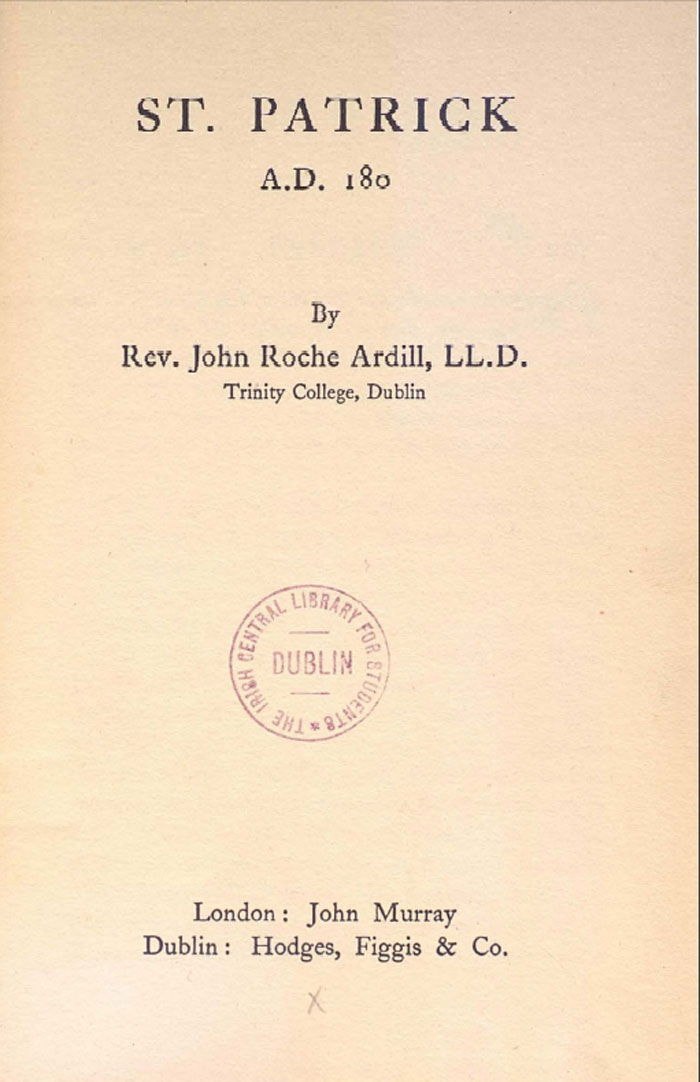St Patrick and Confusion March 17, 2012
Author: Beach Combing | in : Ancient, Medieval , trackbackBeach has always been fascinated by questions of uncertainty in history, in part because these teach modesty, in part because they are a useful way to annoy colleagues. And, in tribute to question marks past, he thought that he would celebrate St Patrick’s day – finally a correct date for an anniversary! – by concentrating on the extraordinary uncertainties about when St Patrick lived, died, preached and was born.
Wikipedia tells us that Patrick came into the world c. 387 which is both cute and mendacious: combining chronic uncertainty (the Latin c.) with spuriously exact knowledge (‘387’). But, in fact, even a great, whopping circa dropped from a ten-storey building does not do justice to just how little we know about Pat’s chronology.
First, Beach must give some sense of the incredible extremes that have been offered. In 1931 John Roche Ardill published a work entitled St. Patrick A.D. 180, whereas other scholars have tried to place St Patrick’s death date in the sixth century! How many ‘great men’ can be said to have a floruit floating over four hundred years!! Any other examples of utter uncertainty of dates for historical individuals: drbeachcombing AT yahoo DOT com
This should be humbling for anyone looking back over the bare expanses of the past: especially in a veritable Dark Age like the first six centuries AD in Ireland. But Irish scholars have never felt any modesty where St Patrick is concerned. In fact, they have defended positions with extraordinary energy and venom. As was noted by one Celticist ‘not a stone has been left unthrown’ in the various attempts to fix Patrick’s dates.
From out of this unpleasant debate has come though an important methodological principle. All evidence relating to Patrick derives from one of two sources: his own writings, two extremely confusing letters or ‘pamphlets’; and later memories and myths about St Patrick. Put simply later writings about the saint are of uncertain value and it is probably safer to simply ignore them for chronological purposes. Patrick’s writings are though reliable and there are some chronological clues to be dug out there.
Most important of all, St Patrick quotes Jerome’s Latin Vulgate in his writings that means he must have been writing post 383 when Jerome’s translation of the New Testament appeared: in other words we can say goodbye to Ardill and his early ilk.
After that though Patrick’s words have been bent to fit almost every circumstance. For example, does his description of his childhood in Britain – Patrick was actually British rather than Irish – describe Late Roman (350-400), what we might call Collapsing Roman (400-420) or Post Roman Britain (420-500)? There have been attempts to defend all of these positions. None have commanded respect, let alone devotion.
Some scholars have tried, likewise, to establish an upper limit to Patrick’s life claiming that he cannot have written later than about 500 because he refers to the Franks as pagans: the Franks had converted to the cross at the end of the fifth century. However, this is a lot of weight to put on a throwaway phrase, particularly given that the Franks continued with their pagan ways well after their official Christianisation!
So perhaps not 400 years of uncertainty but close to 200? Patrick could have died in 390 or he might have died in 540. The joke is that his death date, 17 March, is actually fairly secure: death dates were usually transmitted well. Only that there may have been two or even (according to some) three saints called Patrick in Ireland in the fifth and sixth centuries…Which begs the question which Patrick died on 17 March?
But no, no, enough for this year, back to the green beer: anything more and depression will descend.
***
27 Mar 2012: Jonathan Jarret from a Corner writes in with a new Patrician theory from a Cambridge scholar. ‘Roy Flechner’s argument more or less requires on an early fifth-century floruit for Patrick. The Life of St Germanus appears to show a Roman civil hierarchy functioning as late as 429, and London was still defensible around 457 if the Anglo-Saxon Chronicle’s entry for that year can be trusted (which is hard, given the path that any such date must have had to written record even in the Chronicle’s obscure sources), but how much longer could a decurionate have persisted? Who on earth would have been *taking* the taxes they were supposed to raise, and for what? There is some case for the structures of government hanging on longest in the north-west of England, though, where Carlisle seems still to have had a bishop as late as the 630s, so those who see Patrick as a Strathclyder might line up with Roy anyway… All so much conjecture, of course, given what you rightly say about the sources, but it ties up with several of your regular topics so I thought it was worth pointing out to you!’ Thanks Jonathan!



